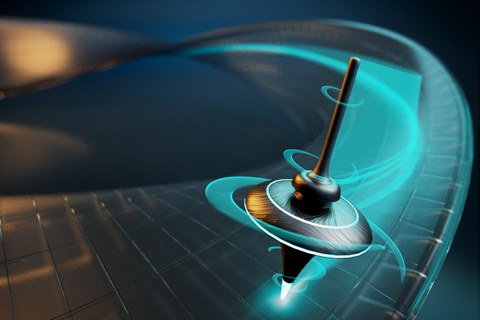Apr 13, 2022
Research: Topological magnon band structure of emergent Landau levels in a skyrmion lattice
In chiral magnets like MnSi the Dzaloshinskii-Moriya interaction stabilizes topologically non-trivial magnetic textures, so-called skyrmions. The fascinating aspect of these configurations is that their non-trivial topology is directly reflected in physical properties. In particular, when a magnon, i.e., a spin wave excitation is propagating across such a texture it collects a Berry phase. This Berry phase can be interpreted to arise from a flux of an emergent orbital magnetic field that is related to the topological skyrmion density of the texture. In other words, when a magnon traverses a skyrmion texture it experiences an emergent Lorentz force that bends the quasi-classical trajectories of the magnon similar to the trajectory of a charged particle that scatters off a local magnetic flux. For a lattice of skyrmions, each of the skyrmions contributes a finite Berry flux such that the average of the emergent orbital magnetic field is finite. This leads to the formation of magnon Landau levels resulting in a magnon band structure which itself is topologically non-trivial characterized by finite Chern numbers.
This magnon band structure was experimentally investigated previously by magnetic resonance and spin wave spectroscopy that, however, probe only spin waves with very long wavelengths in the vicinity of the Γ point of the Brillouin zone. In order to probe spectroscopically the characteristics of the magnon band structures across the entire Brillouin zone different techniques are required. Inelastic neutron scattering, in principle, is such a tool but the resolution in energy and momentum space required for MnSi poses a challenge to state-of-the-art neutron spectroscopy. A collaboration involving researcher from the TU Munich, the Paul-Scherrer institute (Switzerland), the Institute Laue-Langevin (France), ISIS neutron and muon source (UK) and the Karlsruhe Institute of Technology now succeeded to overcome this challenge by combining three distinct scattering methods: time-of-flight, polarized triple-axis, and neutron spin-echo spectroscopy. The combined data is in excellent agreement with theoretical calculations of the spin structure factor, that were carried out by members of our SFB. It provides evidence for the topological characteristics of magnons propagating across a skyrmion lattice.
T. Weber, D. M. Fobes, J. Waizner, P. Steffens, G. S. Tucker, M. Böhm, L. Beddrich, C. Franz, H. Gabold, R. Bewley, D. Voneshen, M. Skoulatos, R. Georgii, G. Ehlers, A. Bauer, C. Pfleiderer, P. Böni, M. Janoschek, M. Garst,
Topological magnon band structure of emergent Landau levels in a skyrmion lattice,
Science 375, 1025 (2022) (arXiv)

